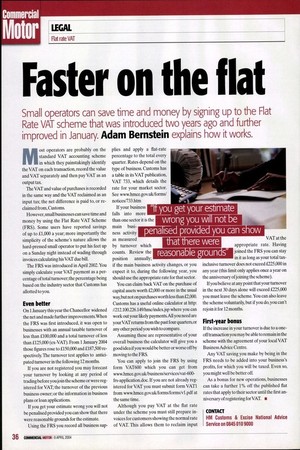Faster on the flat
Page 36

If you've noticed an error in this article please click here to report it so we can fix it.
Small operators can save time and money by signing up to the Flat Rate VAT scheme that was introduced two years ago and further
improved in January. Adam Bernstein explains how it works.
Most operators are probably on the standard VAT accounting scheme in which they painstakingly identify the VAT on each transaction, record the value and VAT separately and then pay VAT as an output tax.
The VAT and value of purchases is recorded in the same way and the VAT reclaimed as an input tax; the net difference is paid to, or reclaimed from, Customs.
However, small businesses can save time and money by using the Flat Rate VAT Scheme (FRS). Some users have reported savings of up to £1,000 a year; more importantly the simplicity of the scheme's nature allows the hard-pressed small operator to put his feet up on a Sunday night instead of wading through invoices calculating his VAT due bill.
The FRS was introduced in April 2002. You simply calculate your VAT payment as a percentage of total turnover; the percentage being based on the industry sector that Customs has allotted to you. Even better
On 1 January this year the Chancellor widened the net and made further improvements.When the FRS was first introduced, it was open to businesses with an annual taxable turnover of less than £100,000 and a total turnover of less than £125,000 (ex-VAT). From 1 January 2004 those figures rose to £150,000 and £187,500 respectively. The turnover test applies to anticipated turnover in the following 12 months.
If you are not registered you may forecast your turnover by looking at any period of trading before you join the scheme or were registered for VAT; the turnover of the previous business owner; or the information in business plans or loan applications.
If you get your estimate wrong you will not be penalised provided you can show that there were reasonable grounds for the estimate. Using the FRS you record all business sup plies and apply a flat-rate percentage to the total every quarter. Rates depend on the type of business. Customs has a table in its VAT publication, VAT 733, which details the rate for your market sector. See www.hmce.gov.uldforms/ notices/733.htrn If your business falls into more than one sector it is the main business activity as measured by turnover which counts. Review the position annually;
if the main business activity changes, or you expect it to, during the following year, you should use the appropriate rate for that sector.
You can claim back VAT on the purchase of capital assets worth £2,000 or more in the usual way, but not on purchases worthless than £2,000. Customs has a useful online calculator at http: //212.100.226.149/hmc/index.jsp where you can work out your likely payments.All you need are your VAT returns from the past four quarters, or any other period you wish to compare.
Assuming these are representative of your overall business the calculator will give you a good idea if you would be better or worse off by moving to the FRS.
You can apply to join the FRS by using form VAT600 which you can get from www.hmce.gov.uk/business/services/vat-600frs-application.doc. If you are not already registered for VAT you must submit form VAT1 from www.hmce.gov.uldforms/forms/v1.pdf at the same time. Although you pay VAT at the flat rate under the scheme you must still prepare invoices for customers showing the normal rate of VAT. This allows them to reclaim input VAT at the appropriate rate. Having joined the FRS you can stay in it as long as your total tax
inclusive turnover does not exceed £225,000 in any year (this limit only applies once a year on the anniversary ofjoining the scheme).
If you believe at any point that your turnover in the next 30 days alone will exceed £225,000 you must leave the scheme. You can also leave the scheme voluntarily, but if you do, you can't rejoin it for 12 months. First-year bonus
If the increase in your turnover is due to a oneoff transaction you may be able to remain in the scheme with the agreement of your local VAT Business Advice Centre.
Any VAT saving you make by being in the FRS needs to be added into your business's profits, for which you will be taxed. Even so, you might well be better off. As a bonus for new operations, businesses can take a further 1% off the published flat rates that apply to their sector until the first anniversary of registering for VAT • CONTACT HM Customs & Excise National Advice Service on 0845 010 9000






































































































